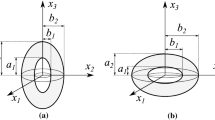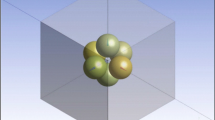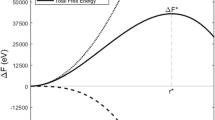Abstract—
Bulk defects in crystals downgrade performance properties of structural materials. Therefore, the problem of reducing the number of discontinuities in solid bodies is one of the most important aspects in modern material science. In this work, the results of computer simulation are presented that showcase the possibility of cavity collapse in a crystal in the state of shear deformation under the influence of shock waves. Similar waves are generated in a solid body exposed to external high-intensity influences. For example, in the displacement cascade propagation zone, there are regions with a mismatch between the thermalization times of atomic vibrations and the removal of heat from them. As a result of the expansion of this region, a shock after cascade wave is generated. The simulation was carried out by the molecular dynamics method using the potential calculated by the embedded atom method. Extended cylindrical cavities, which can be formed after the passing of high-energy ions through a crystal, or, for example, when superheated closed fluid inclusions (mother liquor) reach the surface, are considered as bulk defects. The study has shown that such defects are the source of heterogeneous nucleation of dislocation loops, contributing to a reduction in the shear stresses in the modeled structure. Dependences of the average dislocation density on the shear angle and temperature of the design cell were established, and the loop growth rate was estimated. The generated shock waves create additional tangential stresses that contribute to the formation of dislocation loops; therefore, in this case, dislocations are observed even at small shear strains. If the thermal effect increases during the modeling, the cavity collapses.





Similar content being viewed by others
REFERENCES
Betekhtin, V.I., Porosity and mechanical properties of solids, Vestn. Tomskogo Gos. Univ., 1998, vol. 3, no. 3, pp. 209–210.
Ovchinnikov, V.V., Radiationdynamic effects. Potential for producing condensed media with unique properties and structural states, Phys.-Usp., 2008, vol. 51, no. 9, pp. 955–964. https://doi.org/10.1070/PU2008v051n09ABEH006609
Calder, A.F., Bacon, D.J., Barashev, A.V., and Osetsky, Yu.N., On the origin of large interstitial clusters in displacement cascades, Philos. Mag., 2010, vol. 90, nos. 7–8, pp. 863–884. https://doi.org/10.1080/14786430903117141
Krivtsov, A.M., Molecular dynamics simulation of plastic effects upon spalling, Phys. Solid State, 2004, vol. 46, no. 6, pp. 1055–1060. https://doi.org/10.1134/1.1767244
Zol’nikov, K.P., Korchuganov, A.V., Kryzhevich, D.S., Chernov, V.M., and Psakh’e, S.G., Shock waves in metal crystallites under radiation exposure, Vopr. Atomnoi Nauki Tekh. Ser. Termoyadernyi Sintez, 2015, vol. 38, no. 2, pp. 68–74.
Markidonov, A.V., Starostenkov, M.D., Pavlovskaya, E.P., Yashin, A.V., and Poletaev, G.M., Low-temperature dissolution of a pore near the crystal surface under the influence of shock waves, Fundam. Probl. Sovrem. Materialoved., 2013, vol. 10, no. 2, pp. 254–260.
Markidonov, A.V., Starostenkov, M.D., Pavlovskaya, E.P., Yashin, A.V., Medvedev, N.N., and Zakharov, P.V., Structural transformation of vacancy pores in a deformed crystal under the action of shock waves, Fundam. Probl. Sovrem. Materialoved., 2013, vol. 10, no. 4, pp. 563–571.
Markidonov, A.V., Starostenkov, M.D., Zakharov, P.V., and Obidina, O.V., Pore formation in an FCC crystal under the action of post-cascade shock waves, Fundam. Probl. Sovrem. Materialoved., 2015, vol. 12, no. 2, pp. 231–240.
Markidonov, A.V., Starostenkov, M.D., and Poletaev, G.M., Transformation of nanopores in gold under conditions of thermal activation and exposure to sound and shock waves, Bull. Russ. Acad. Sci.: Phys., 2015, vol. 79, no. 9, pp. 1089–1092. https://doi.org/10.3103/S1062873815090130
Markidonov, A.V., Starostenkov, M.D., Zakharov, P.V., Lubyanoi, D.A., and Lipunov, V.N., Emission of dislocation loops from nanovoids in an FCC crystal subjected to shear deformation under post-cascade shock waves, J. Exp. Theor. Phys., 2019, vol. 129, pp. 985–989. https://doi.org/10.1134/S106377611911013X
Barbu, A., Dunlop, A., Lesueur, D., and Averback, R.S., Latent tracks do exist in metallic materials, Europhys. Lett., 1991, vol. 15, no. 1, pp. 37–42. https://doi.org/10.1209/0295-5075/15/1/007
Prokof’ev, M.A., Berdonosova, D.G., Melikhov, I.V., and Berdonosov, S.S., On the possibility of obtaining crystalline materials containing extended cylindrical pores, Moscow Univ. Chem. Bull., 2010, vol. 65, no. 4, pp. 269–273. https://doi.org/10.3103/S0027131410040115
Foiles, S.M., Baskes, M.I., and Daw, M.S., Embedded-atom-method functions for the fcc metals Cu, Ag, Au, Ni, Pd, Pt, and their alloys, Phys. Rev. B, 1986, vol. 33, no. 12, pp. 7983–7991. https://doi.org/10.1103/PhysRevB.33.7983
XMD—Molecular dynamics for metals and ceramics. http://xmd.sourceforge.net/about.html. Cited January 30, 2020.
Stukowski, A., Visualization and analysis of atomistic simulation data with OVITO—The Open Visualization Tool, Mod. Simul. Mater. Sci. Eng., 2010, vol. 18, p. 015012. https://doi.org/10.1088/0965-0393/18/1/015012
Andersen, H.C., Molecular dynamics simulations at constant pressure and/or temperature, J. Chem. Phys., 1980, vol. 72, no. 4, pp. 2384–2393. https://doi.org/10.1063/1.439486
Stukowski, A. and Albe, K., Extracting dislocations and non-dislocation crystal defects from atomistic simulation data, Mod. Simul. Mater. Sci. Eng., 2010, vol. 18, no. 8, p. 085001. https://doi.org/10.1088/0965-0393/18/8/085001
Stukowski, A., Bulatov, V.V., and Arsenlis, A., Automated identification and indexing of dislocations in crystal interfaces, Mod. Simul. Mater. Sci. Eng., 2012, vol. 20, no. 8, p. 085007. https://doi.org/10.1088/0965-0393/20/8/085007
Stukowski, A., Computational analysis methods in atomistic modeling of crystals, JOM, 2014, vol. 66, no. 3, pp. 399–407. https://doi.org/10.1007/s11837-013-0827-5
Norman, G.E. and Yanilkin, A.V., Homogeneous nucleation of dislocations, Phys. Solid State, 2011, vol. 53, no. 8, pp. 1614–1619. https://doi.org/10.1134/S1063783411080221
Xue, L., Constitutive modeling of void shearing effect in ductile fracture of porous materials, Eng. Fract. Mech., 2008, vol. 75, no. 11, pp. 3343–3366. https://doi.org/10.1016/j.engfracmech.2007.07.022
Kozlov, E.V., Trishkina, L.I., and Koneva, N.A., Scalar dislocation density and its components accumulated during deformation in low-concentration Cu–Al solid solutions, Fundam. Probl. Sovrem. Materialoved., 2011, vol. 8, no. 1, pp. 52–60.
Skuratov, V.A., Saifulin, M.M., Aralbaeva, G.M., O’Connell, J.H., and van Vuuren, A.J., Damage of titanium dioxide near the surface after irradiation with fast heavy ions, Vestn. Karagandinskogo Univ. Fiz., 2017, no. 1, pp. 47–54.
Zhilyaev, P.A., Kuksin, A.Yu., Norman, G.E., Starikov, S.V., Stegailov, V.V., and Yanilkin, A.V., Influence of material microstructure on dynamic plasticity and strength: Molecular dynamics modelling, Fiz.-Khim. Kinetika Gaz. Din., 2010, vol. 9, no. 1, pp. 104–109.
Kositski, R., Steinberger, D., Sandfeld, S., and Mordehai, D., Shear relaxation behind the shock front in ❬110❭ molybdenum—From the atomic scale to continuous dislocation fields, Comput. Mater. Sci., 2018, vol. 149, pp. 125–133. https://doi.org/10.1016/j.commatsci.2018.02.058
Tang, J.F., Xiao, J.C., Deng, L., Li, W., Zhang, X.M., Wang, L., Xiao, S.F., Deng, H.Q., and Hu, W.Y., Shock wave propagation, plasticity, and void collapse in open-cell nanoporous Ta, Phys. Chem. Chem. Phys., 2018, vol. 20, no. 44, pp. 28039–28048. https://doi.org/10.1039/C8CP05126G
Starostenkov, M.D., Potekaev, A.I., Markidonov, A.V., Kulagina, V.V., and Grinkevich, L.S., Dynamics of edge dislocations in a low-stability FCC-system irradiated by high-energy particles, Russ. Phys. J., 2017, vol. 59, no. 9, pp. 1446–1453. https://doi.org/10.1007/s11182-017-0929-6
Ackland, G.J. and Jones, A.P., Applications of local crystal structure measures in experiment and simulation, Phys. Rev. B, 2006, vol. 73, no. 5, p. 054104. https://doi.org/10.1103/PhysRevB.73.054104
Terekhov, S.V. and Limanovskii, A.I., “Phase of emptiness” and diffuse phase transition, Fiz. Tekh. Vysokikh Davlenii, 2018, vol. 28, no. 3, pp. 65–74.
Terekhov, S.V., Fuzzy phase transition in amorphous Fe40Ni40P14B6 alloy: Thermodynamics of phases and kinetics of crystallization, Fiz. Tekh. Vysokikh Davlenii, 2019, vol. 29, no. 2, pp. 24–39.
Author information
Authors and Affiliations
Corresponding authors
Additional information
Translated by S. Kuznetsov
About this article
Cite this article
Markidonov, A.V., Starostenkov, M.D., Lubyanoi, D.A. et al. Modeling of Healing Cylindrical Cavities Exposed to Shock Waves in Crystal Subjected to Shear Deformation. Steel Transl. 52, 208–214 (2022). https://doi.org/10.3103/S0967091222020127
Received:
Revised:
Accepted:
Published:
Issue Date:
DOI: https://doi.org/10.3103/S0967091222020127




